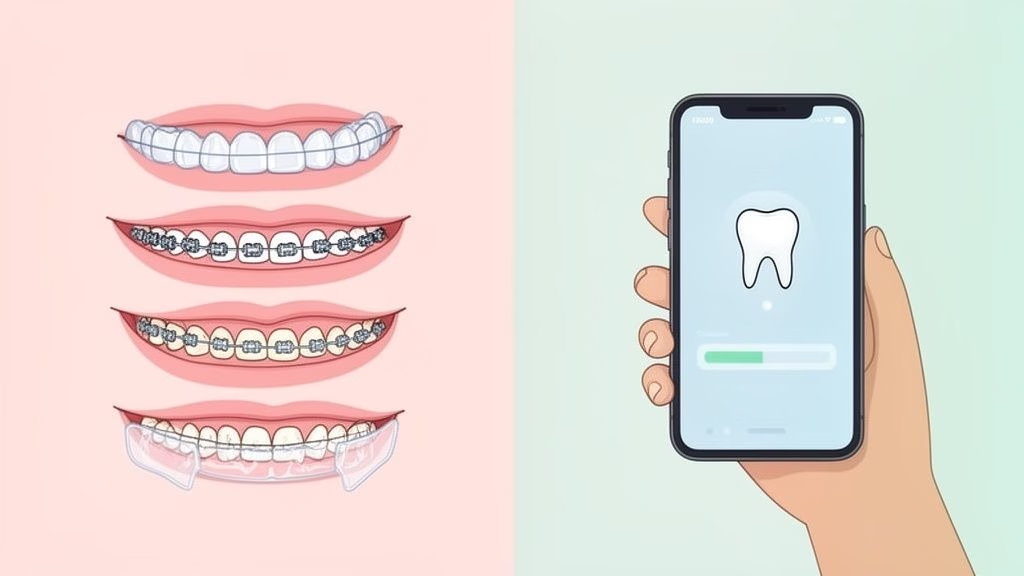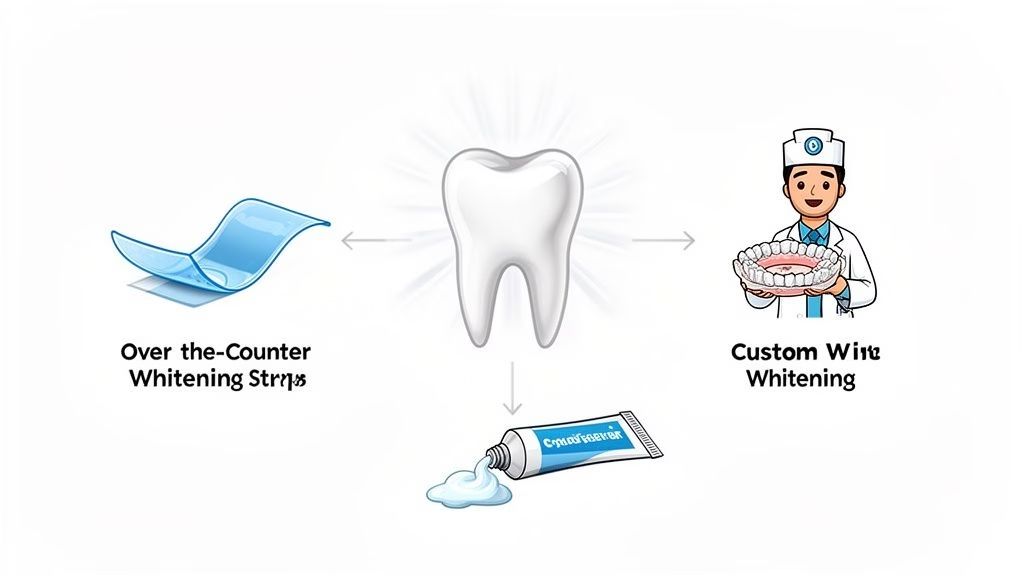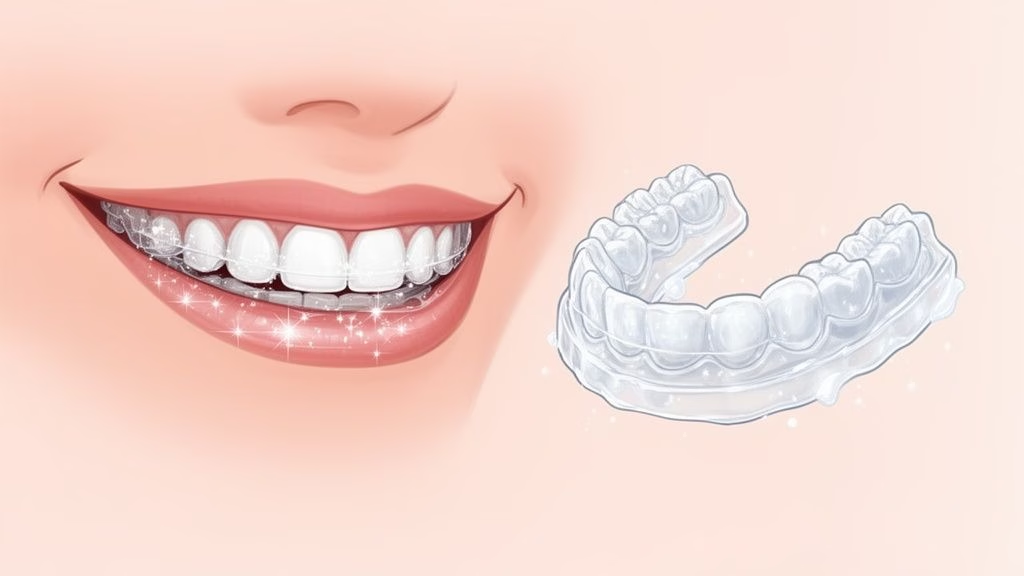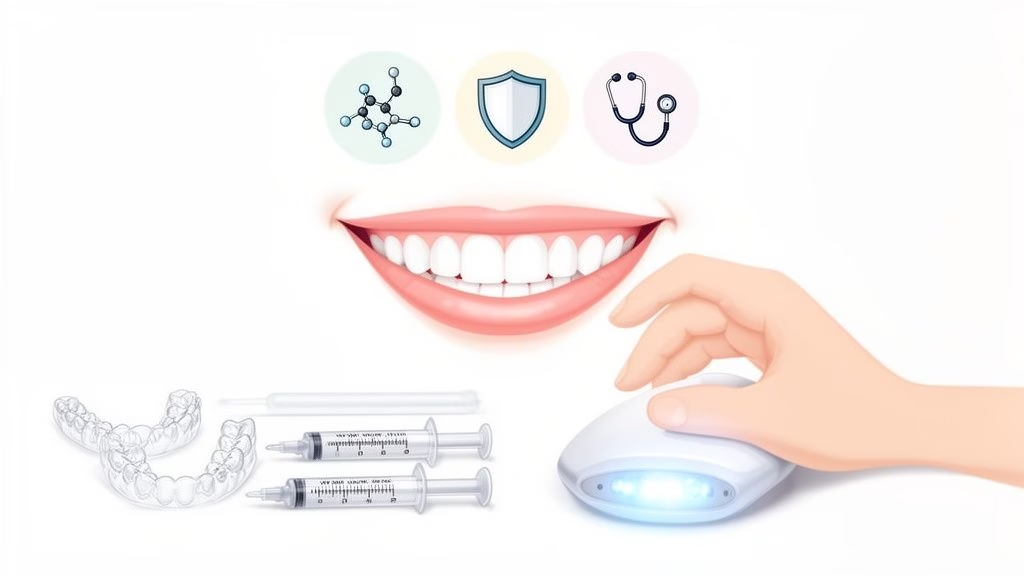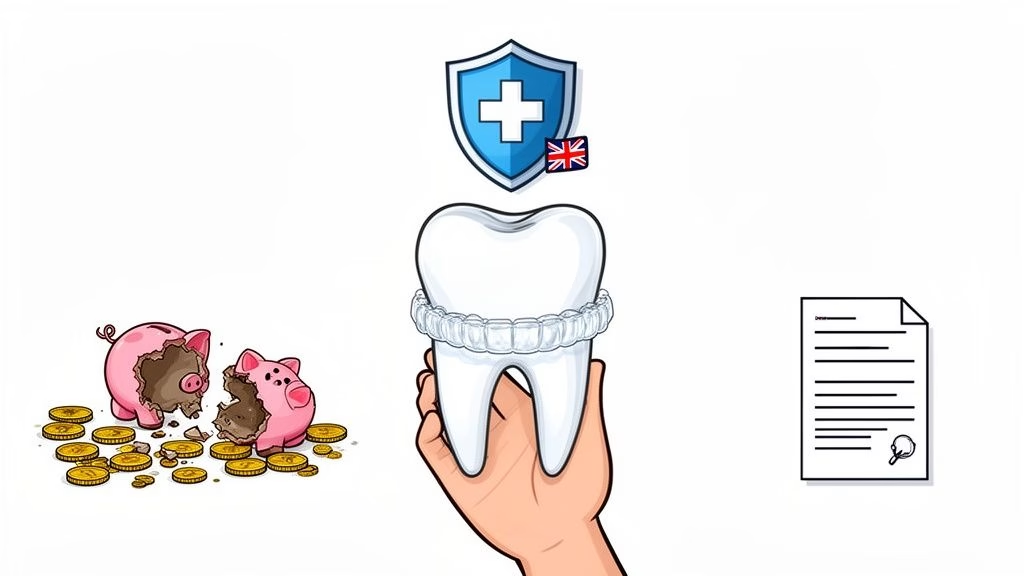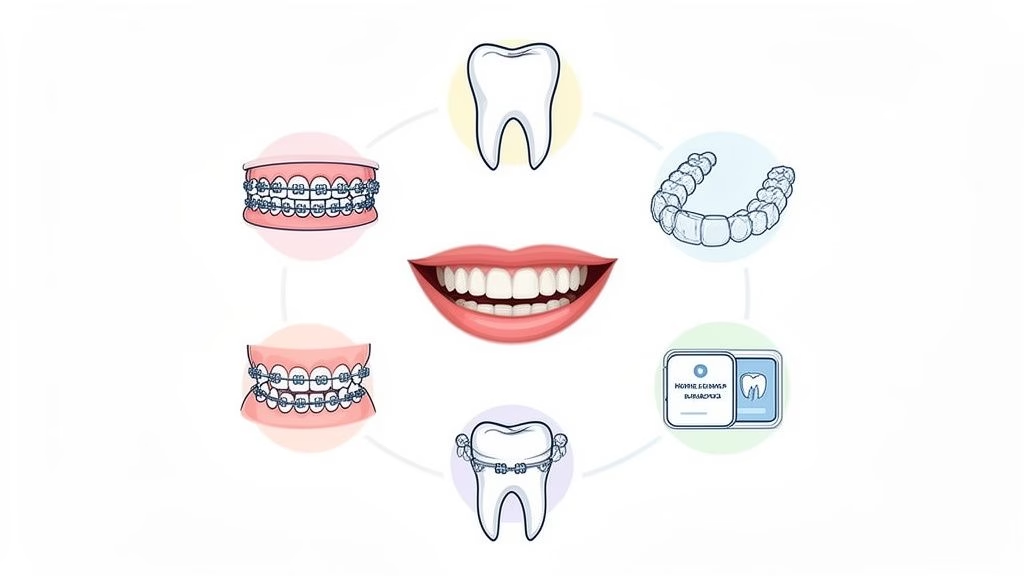What Is Dental Sedation? A Guide to Calm Dentistry
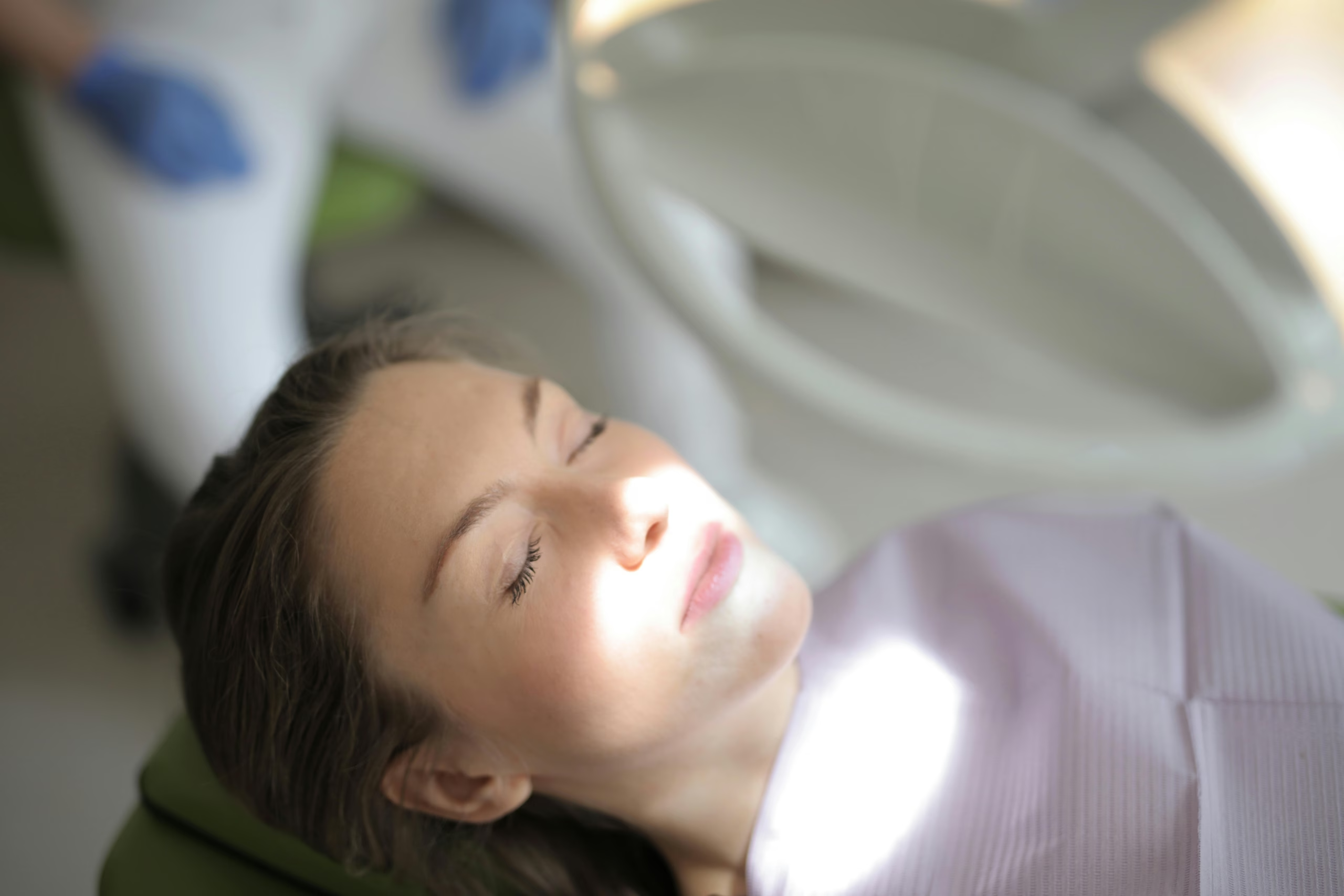
Dental sedation is a technique we use to help patients feel completely relaxed and comfortable during their appointments. It involves using carefully administered medication to create a calm, anxiety-free experience, which means even people with significant dental fears can get the treatment they need.
Think of it as a comfort-control dial for your dental visit. We can adjust the level of sedation to turn down your stress and help you feel deeply relaxed.
Making Dental Care Accessible for Everyone
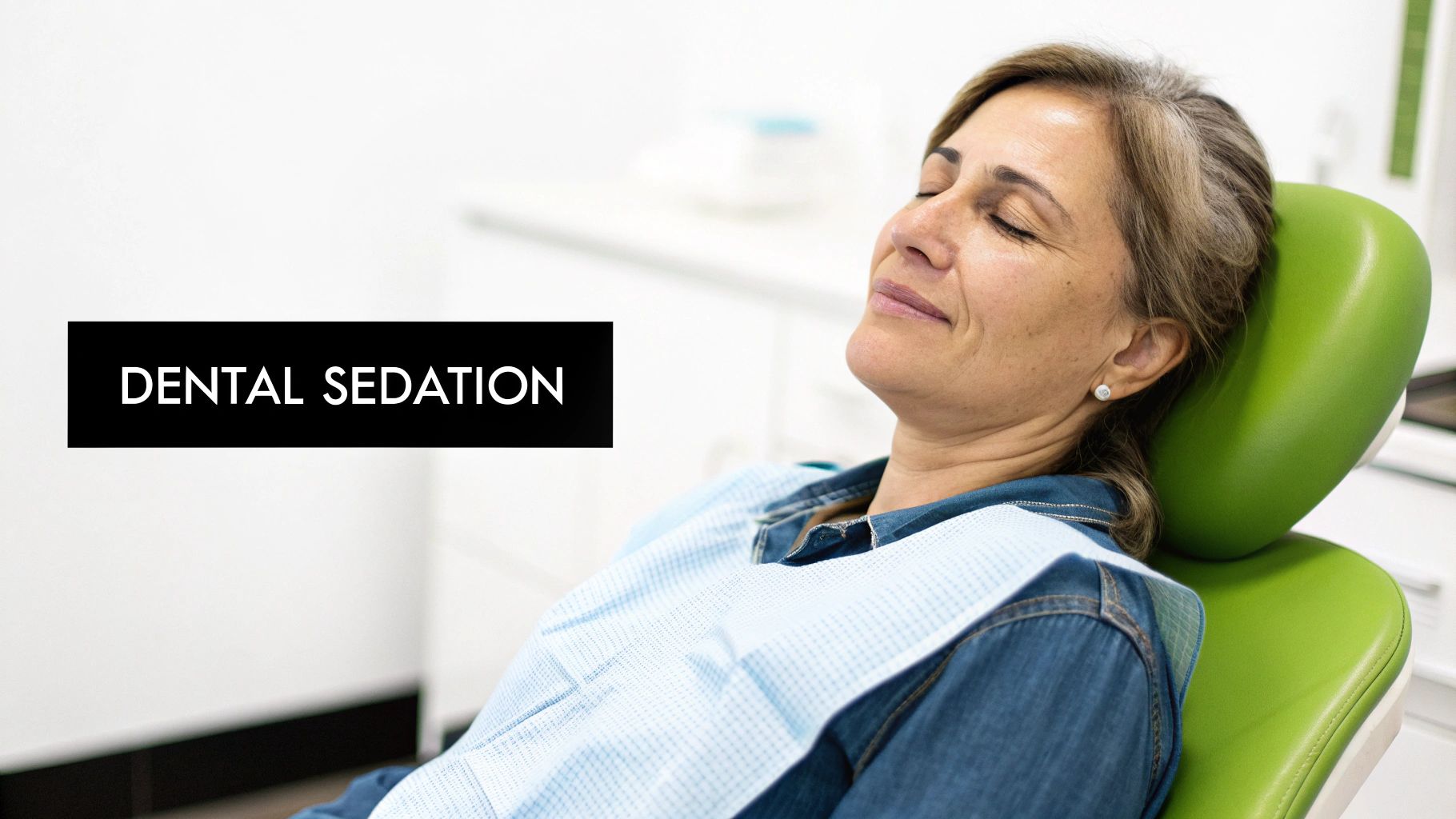
For millions of people, just the thought of a dental chair can trigger real fear, often leading to cancelled appointments and worsening oral health. Dental sedation is the solution to this problem, turning what could be a stressful ordeal into a manageable, even positive, experience.
It’s a common misconception that sedation means being “put to sleep.” In most cases, it’s not about unconsciousness at all. Instead, it’s about reaching a state of deep relaxation where you are still awake but feel completely at ease and unbothered by the procedure.
This approach is a cornerstone of modern dentistry, ensuring that anxiety doesn’t get in the way of a healthy smile. Whether you need an emergency dental consultation, are thinking about cosmetic work, or want to explore smarter teeth straightening options, sedation can make it all possible.
Why Is Sedation So Important in the UK?
Dental anxiety isn’t a minor issue; it affects a huge portion of the population. Here in the UK, it’s a massive barrier to people getting the care they need. Recent data shows that over 1 in 4 Britons—that’s more than 14 million people—suffer from severe dental anxiety, causing them to delay or avoid appointments altogether.
This problem is particularly widespread among adults aged 25-40, stopping them from getting everything from routine check-ups to more advanced treatments. You can explore more data on UK dental anxiety and see the full picture of its impact. This really highlights just how crucial sedation is. It offers a practical way for patients to take back control of their oral health without the fear.
Sedation dentistry acts as a bridge, connecting anxious patients with the high-quality care they deserve. It ensures that fear is no longer a barrier to a healthy, confident smile.
The True Purpose of Dental Sedation
At its heart, dental sedation is about more than just calming nerves. It’s a tool that opens up access to all kinds of dental work, making procedures more efficient and comfortable for both the patient and the dentist.
The main goals are to:
- Reduce Anxiety and Fear: Its number one job is to create a sense of calm, switching off that fight-or-flight response that many patients experience.
- Manage Pain and Discomfort: While sedation isn’t a painkiller, it works brilliantly alongside local anaesthetics to ensure the entire experience is pain-free.
- Allow for Longer Procedures: For complex treatments like a full smile makeover or even getting you fitted for clear aligners as an alternative to a specific aligner brand, sedation allows dentists to work for longer periods without interruption.
- Control the Gag Reflex: It’s also incredibly helpful for suppressing a strong gag reflex, a common problem that can make dental work very difficult.
Ultimately, understanding dental sedation reveals its true value. It’s a safe and effective way to make modern dental solutions, like those we offer at Toothfairy, accessible to everyone.
What Are My Dental Sedation Options?
Thinking about dental sedation isn’t about an on/off switch for anxiety. It’s more like a dimmer, with different settings designed to provide just the right amount of comfort for your specific needs. The best option for you will come down to a conversation with your dentist, factoring in your anxiety levels, your medical history, and the type of treatment you’re having.
Whether you’re in for a routine clean, an unexpected emergency appointment, or beginning your journey with clear aligners, there’s a sedation method to make the experience a positive one. Let’s look at the most common types.
Nitrous Oxide: Taking the Edge Off
You’ve probably heard of this one as ‘laughing gas’. Nitrous oxide is the gentlest form of sedation on the menu. You simply breathe a mixture of the gas and oxygen through a small, comfortable mask placed over your nose. It doesn’t put you to sleep; instead, it creates a warm, floaty feeling of well-being that makes any worries just drift away.
The best part? The effects come on quickly and fade just as fast. As soon as the mask is off, the gas leaves your system within minutes. This means you can drive yourself home and get right back to your day without any lingering grogginess. It’s a fantastic choice for anyone with mild dental nerves or for shorter procedures.
Oral and IV Sedation: Deeper Relaxation
For those who need a bit more help to feel truly at ease, moderate sedation is the next step up. These methods create a state of deep relaxation often called ‘conscious sedation’ – you’re still awake, but you’ll be blissfully unaware of the treatment itself.
- Oral Conscious Sedation: This is as simple as taking a pill. Your dentist will prescribe a sedative for you to take about an hour before you come in. By the time you settle into the chair, you’ll feel deeply relaxed and drowsy. Most people have little to no memory of the procedure afterwards, which is a huge plus for anxious patients.
- Intravenous (IV) Sedation: Here, the sedative is delivered directly into your bloodstream through a small tube in your arm or hand. This gives your dentist precise control over your sedation level throughout the entire appointment, and the calming effects are almost instant. Just like with the oral method, you’re unlikely to remember much about the treatment.
A crucial point for both these options: you absolutely must have a trusted friend or family member to take you home. The sedative effects linger for several hours, so plan on taking it easy for the rest of the day. Driving is strictly off-limits for at least 24 hours to ensure you’re completely safe.
This image helps to show the different levels of consciousness you can expect with each choice.
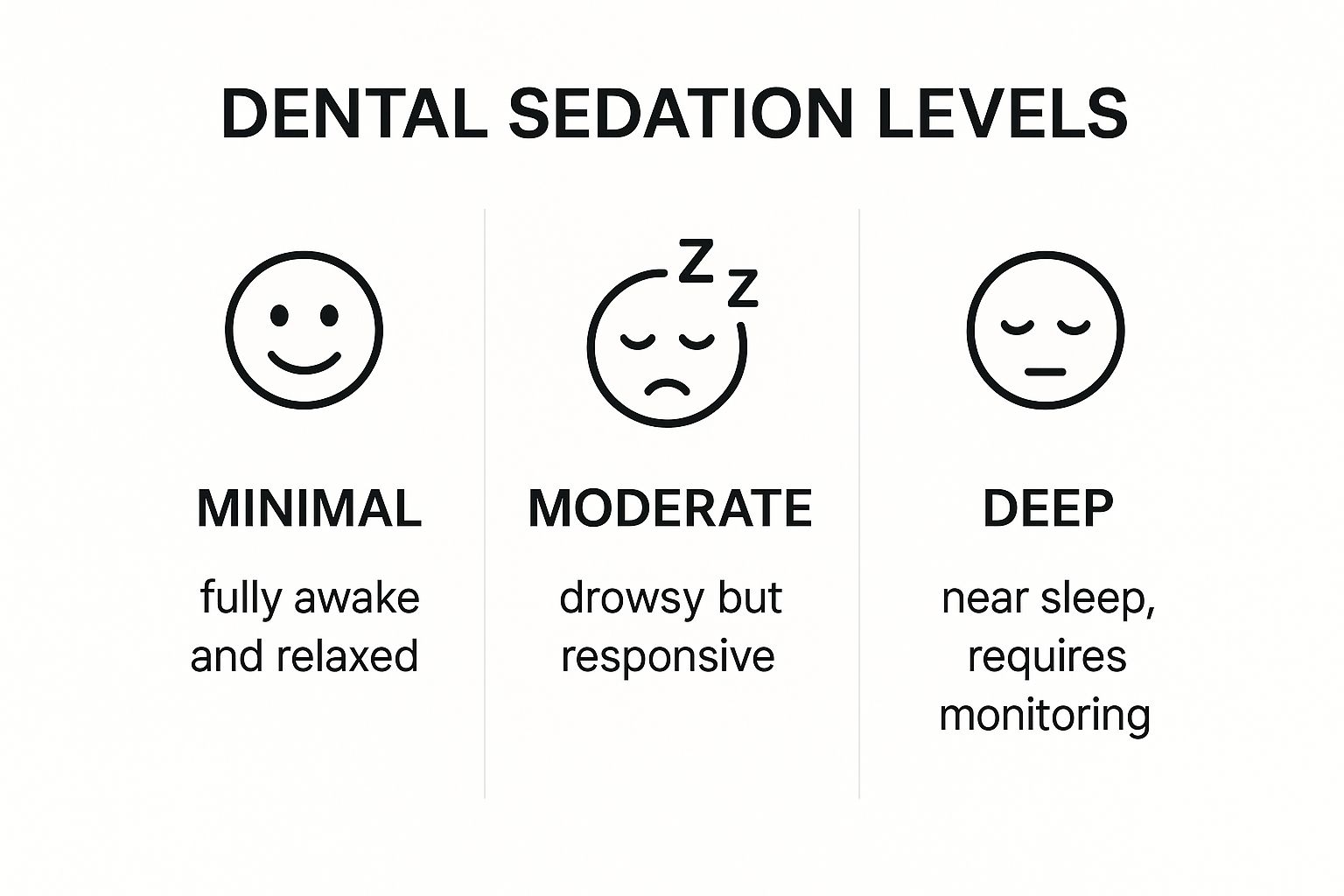
The main thing to remember is that sedation is about being comfortable and relaxed, not necessarily unconscious. You’re still able to respond to your dentist, but you’re in a much calmer state of mind.
To make comparing your options even easier, here’s a quick breakdown of how each method stacks up.
Comparing Dental Sedation Options at a Glance
| Sedation Type | How It’s Administered | Level of Consciousness | Best For | Recovery Time |
|---|---|---|---|---|
| Nitrous Oxide | Inhaled through a nose mask | Conscious and relaxed | Mild anxiety, short procedures | A few minutes; can drive home |
| Oral Sedation | A prescribed pill taken pre-appointment | Conscious but very drowsy | Moderate anxiety, longer procedures | Several hours; needs an escort home |
| IV Sedation | Injected directly into a vein | Deeply sedated, ‘twilight sleep’ | Moderate to severe anxiety, complex work | Several hours to 24 hours; needs an escort home |
| General Anaesthesia | Administered by an anaesthetist | Completely unconscious | Extensive surgery, specific medical needs | Full day or longer; hospital setting |
This table gives you a clear, side-by-side look, but the best way to choose is by talking it through with your dental team. They’ll help you find the perfect fit for your needs.
Deep Sedation and General Anaesthesia
At the far end of the spectrum, we have deep sedation and general anaesthesia. These are reserved for very specific cases and involve putting you in a state of near or total unconsciousness. You’ll typically find these options in a hospital or a specialised surgical centre, administered by a qualified anaesthetist.
General anaesthesia is usually only considered for extensive oral surgeries or for patients with medical conditions that make other forms of sedation unsuitable.
At Toothfairy, our goal is to make dental care feel easy and accessible. Sedation is one of the most important tools we have to help patients overcome their fears, whether they need urgent care or are looking for smarter teeth straightening solutions. By exploring these options, you can create a plan that turns your dream smile into a comfortable reality.
Who Can Benefit from Dental Sedation?
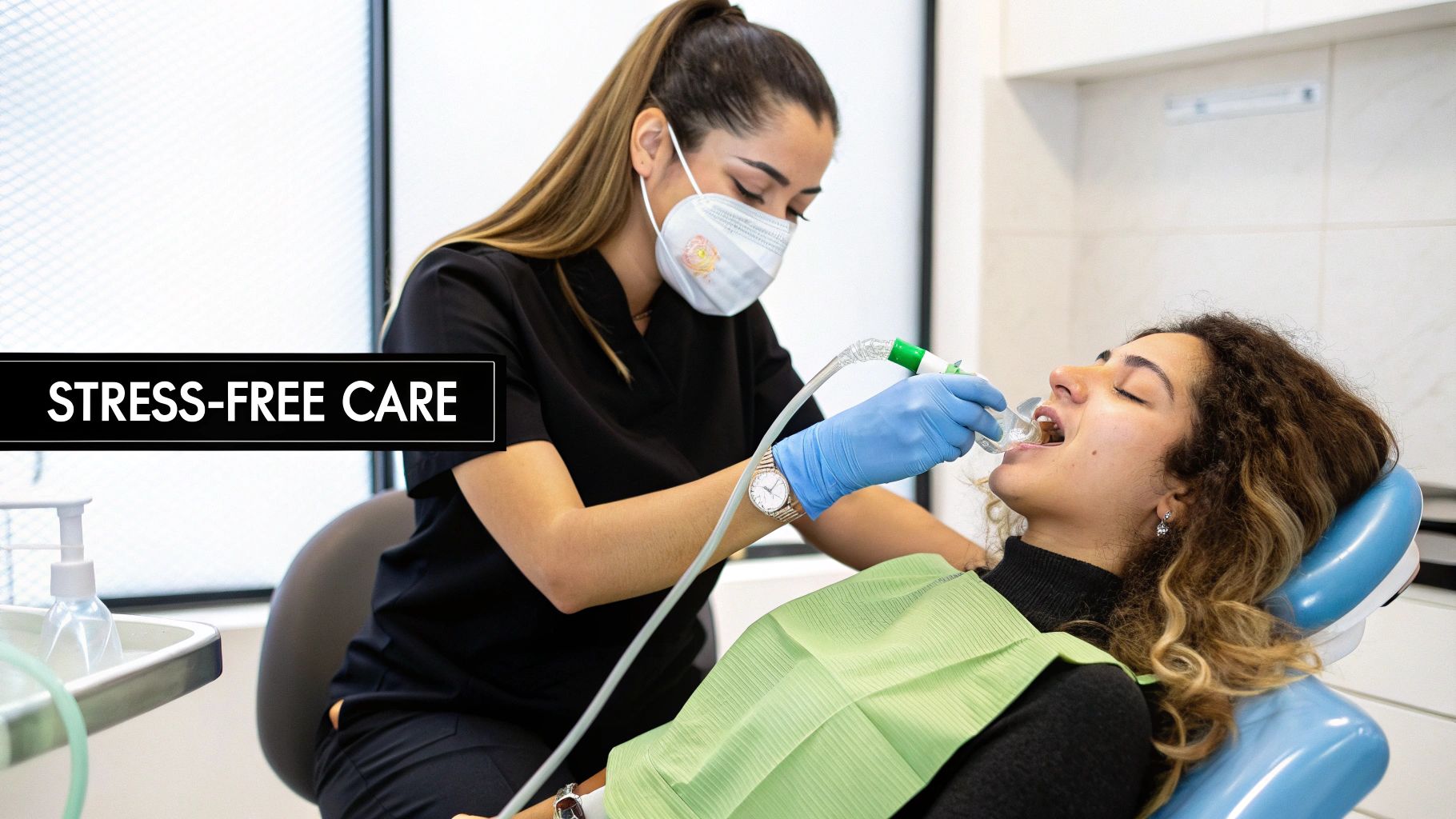
When you hear “dental sedation,” your mind probably jumps straight to people with a deep-seated fear of the dentist. While it’s certainly a game-changer for anyone with dental anxiety, its benefits are much broader than you might think.
It’s easy to assume sedation is only for severe phobias, but that’s just scratching the surface. It’s a valuable tool that helps all sorts of people overcome very real hurdles to getting the care they need.
It’s Not Just About Fear
Dental anxiety is a big piece of the puzzle, but many other common issues can make a trip to the dentist feel like an ordeal. Sedation offers a practical, effective solution.
- A Low Pain Threshold: Let’s face it, some of us are just more sensitive to pain. Sedation works alongside local anaesthetic to raise your pain threshold, so all you feel is a sense of deep calm.
- A Sensitive Gag Reflex: For some, an overactive gag reflex can turn even a simple check-up into a battle. Sedation helps to relax this involuntary response, allowing your dentist to work without causing you any distress.
- Difficulty Sitting Still: If you have a medical or physical condition that makes staying in one position uncomfortable, a long appointment can seem impossible. Sedation helps your body relax completely, making even extended treatments entirely manageable.
The real beauty of sedation is that it removes barriers to care. Whether that barrier is physical discomfort, an involuntary reflex, or overwhelming anxiety, sedation clears the way for you to achieve excellent oral health.
Making Complex Dentistry Possible
Sedation is also indispensable for anyone needing extensive or complex dental work. Think about major restorative treatments or a complete smile makeover—these often require several procedures.
With sedation, your dentist can often group multiple treatments into a single, longer appointment. This is a huge advantage. It saves you the time and stress of coming back again and again.
For example, if you’re looking into cosmetic work, like getting fitted for a smarter teeth straightening solution from Toothfairy, sedation ensures the process is smooth from start to finish. It puts that dream smile comfortably within your reach.
This approach reflects a big shift in UK dentistry. In the past, it was thought that only about 5% of patients needed sedation. But as dental anxiety becomes more widely recognised, that number is on the rise. You can read more about how sedation needs are evolving in UK dentistry and how it’s shaping patient care. Ultimately, sedation empowers people who might have once felt that transformative dental work was simply not for them.
What to Expect at Your Dental Sedation Appointment
Walking into any dental appointment can be a bit daunting, but knowing exactly what’s going to happen can make all the difference. When it comes to sedation, the whole process is designed around you, making sure you’re safe, comfortable, and completely at ease from the moment you arrive. Think of it less like a clinical procedure and more like a carefully guided path to relaxation.
It all starts with a proper chat. Before anything happens, your dental team will sit down with you to go over your medical history, any medications you’re taking, and, most importantly, your own feelings and anxieties. This conversation is key to choosing the right type of sedation for you.
On the Day of Your Visit
Depending on the type of sedation you’ve agreed upon, things will get started before you’re even in the dental chair. If you’re having oral sedation, for example, you’ll likely take a small pill about an hour before your appointment. That way, you’ll already be feeling calm by the time the treatment begins.
For other methods, the sedative is given once you’re comfortably settled.
- Nitrous Oxide: You’ll have a small, soft mask placed over your nose and all you have to do is breathe normally. The happy, floaty feeling usually kicks in within a few minutes.
- IV Sedation: A tiny tube (a cannula) is placed into a vein, typically in your arm or the back of your hand. The sedative goes directly into your bloodstream, so it starts working almost instantly.
No matter which option is used, your safety is always the number one priority. The dental team will be monitoring your heart rate, blood pressure, and oxygen levels constantly throughout the procedure. You’re in very safe hands.
You are never left on your own during sedation. A trained professional is right there with you the entire time, keeping a close eye on everything to make sure you’re perfectly safe and comfortable.
During the Procedure and Afterwards
Once the sedation takes effect, you’ll drift into a state of deep relaxation. It’s important to know you won’t actually be asleep (unless you’re having general anaesthesia), but you’ll be so relaxed that you’ll be completely unconcerned with the dental work happening. Many people say it feels like a pleasant dream and often have little to no memory of the treatment afterwards—a huge plus for anyone with dental phobia.
When your treatment is finished, the recovery phase begins, and what that looks like depends on the sedation you had.
- Nitrous oxide is very quick to wear off. As soon as the mask is removed, you’ll start feeling like your old self again within minutes. You’ll even be able to drive yourself home safely.
- Oral or IV sedation takes a bit longer to fade. You’ll feel quite sleepy and a bit groggy for several hours, so you absolutely must have a trusted friend or family member to take you home and stay with you for a while.
We can’t stress this enough: you must not drive for at least 24 hours after oral or IV sedation. Even if you feel fine, your judgement and reaction times are still affected. Plan to take the rest of the day off to just relax and recover. It’s the perfect way to cap off a stress-free trip to the dentist.
How Sedation Unlocks Modern Cosmetic Dentistry
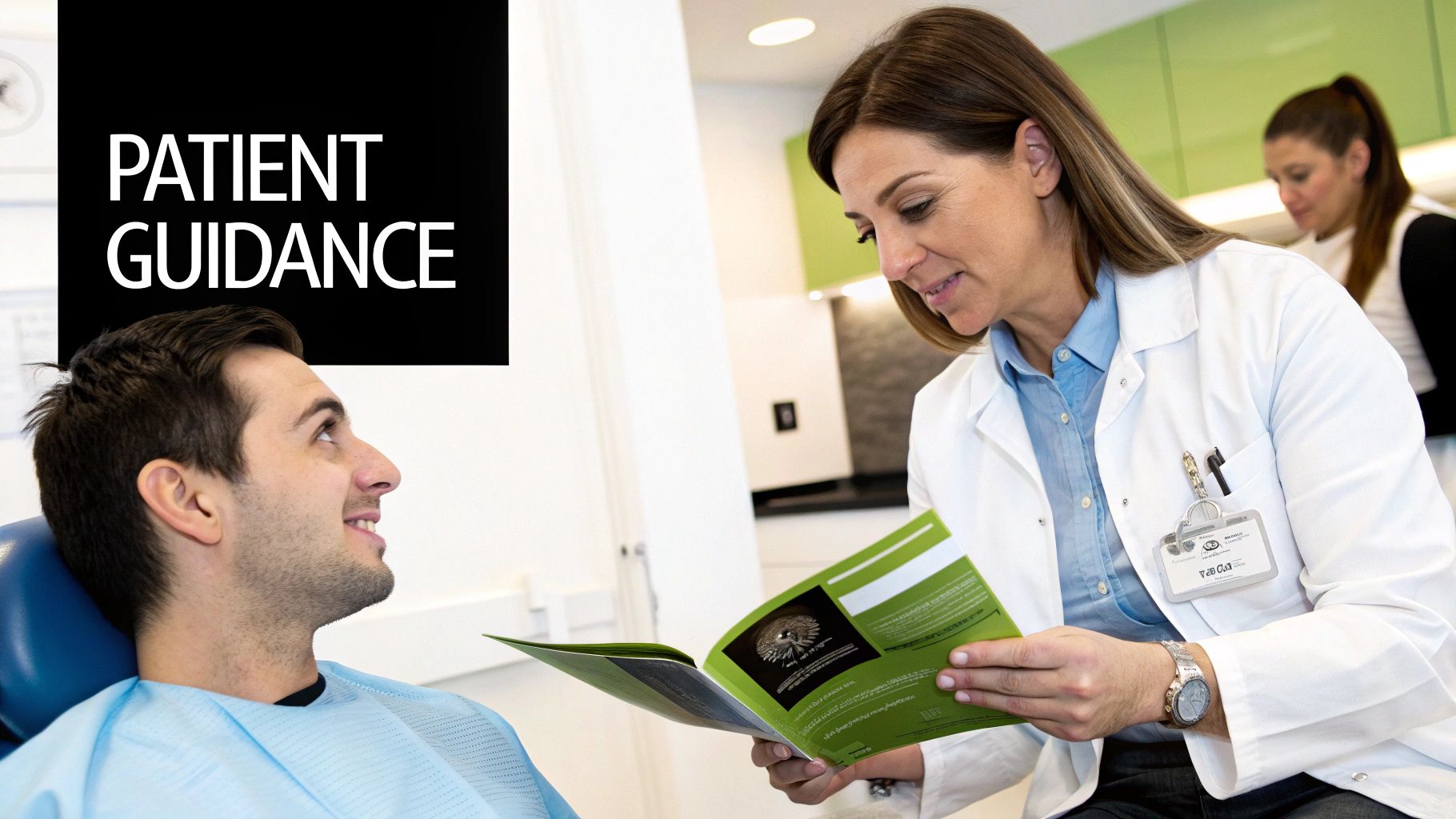
Dental sedation is about much more than just calming nerves. In reality, it’s the key that opens the door to the incredible possibilities of modern cosmetic dentistry.
For many people, the thought of getting veneers, having their gums contoured, or undergoing a full smile makeover seems impossible. The sheer amount of time in the chair and the complexity of the work can feel completely overwhelming. Sedation changes all of that.
By helping you reach a state of deep relaxation, sedation allows your dentist to carry out longer, more detailed procedures in a single session. This is a game-changer. Instead of stretching treatments over several appointments, a complete cosmetic transformation can often be finished while you rest comfortably, with little to no awareness of the time passing.
For anyone with a busy life, this efficiency is a massive plus. It means far fewer disruptions to your routine and a much quicker journey to the confident smile you’ve always dreamed of.
Accessing Smarter Dental Solutions
The practical benefits of sedation make many treatments more affordable and convenient, like the teeth-straightening solutions we offer here at Toothfairy. Getting fitted for clear aligners or having the preparatory work done for a bigger cosmetic plan becomes a genuinely stress-free experience. The anxiety that once stood in the way just melts away.
Put simply, sedation makes these smarter dental options accessible to everyone. It ensures that fear no longer gets to make decisions about your smile for you.
Sedation dentistry turns the dream of a perfect smile into an achievable and genuinely comfortable reality. It’s the bridge between wanting cosmetic work and actually going through with it.
Research backs this up time and time again, showing just how crucial sedation is for a huge range of treatments. One seven-year study on IV sedation, for instance, found it was essential for completing procedures in complex patient groups.
Of the cases they looked at, 53.4% involved dental exams and 42.3% involved extractions, highlighting its role in making vital care manageable for those who need it most. You can read more about the findings in this study on sedation’s effectiveness.
Ultimately, sedation gives you the confidence to pursue the smile you deserve without hesitation.
Your Dental Sedation Questions Answered
It’s completely normal to have questions before going ahead with dental sedation. Understanding the process is the first step towards feeling at ease, so let’s walk through some of the things our patients often ask.
Will I Be Completely Asleep?
This is a common misconception. Unless you’re having general anaesthesia in a hospital setting, you won’t be fully unconscious. Most dental sedation methods, like oral tablets or IV sedation, lead to a state called ‘conscious sedation’.
What does this mean? It means you’ll be in a deep state of relaxation—think of it as being incredibly sleepy and blissfully calm. You’ll still be able to hear your dentist and respond to simple instructions, but most people remember little, if anything, about the procedure afterwards.
Is Dental Sedation Safe for Everyone?
For most people, yes, sedation is very safe when managed by a properly trained dental team. Safety is always our number one priority, which is why we start with a thorough review of your medical history to make sure it’s a good fit for you.
There are some situations where sedation might not be suitable. For example, conditions like pregnancy, certain allergies, or specific respiratory problems could be a factor. That’s why it’s so important to be upfront about your health and any medications you’re taking during your initial chat with us.
How Much Does Dental Sedation Cost in the UK?
The price tag for dental sedation can differ quite a bit. It really depends on the type you have, how long your treatment takes, and the individual dental practice. Nitrous oxide (or ‘laughing gas’) is usually the most budget-friendly choice. IV sedation, on the other hand, costs more because it requires specialised training and continuous monitoring throughout your visit.
Some sedation treatments might be covered by the NHS if you meet certain clinical needs, but for private or cosmetic work, you’ll likely need to fund it yourself. We always recommend getting a clear, detailed breakdown of all the costs involved before you commit.
A key question many people ask is, “Will I need to take time off work?” The answer is yes, for anything other than nitrous oxide. You should plan to take the rest of the day off to recover fully. The effects of oral and IV sedation can take several hours to wear off, and you must not drive for at least 24 hours. You will need a responsible adult to take you home and stay with you.
Ready to explore your options for a calmer dental experience? At Toothfairy, we make dental care accessible and stress-free, from emergency appointments to smarter teeth straightening solutions. Visit Toothfairy to learn how we can help you achieve your dream smile with confidence.
Last updated on August 18, 2025

Dr. Deepak
ToothFairy Care Team.
Dr. Deepak
ToothFairy Care Team.
